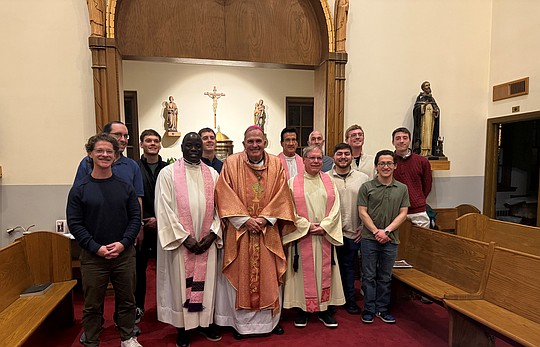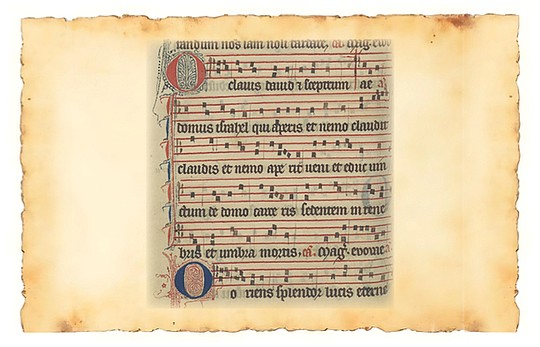How to become a mystic amid the popular media culture
November 4, 2023 at 11:29 a.m.

Integrating our faith with our media use is a real challenge, particularly as adverse media messages often run so contrary to our values. How can we bring faith into our digital media dialogue without losing who we are as Christians? How can we become holy within a culture that often tempts us toward the opposite?
I believe we are each called to be mystics in the time and circumstance God has placed us which, today, means within a media culture. The popular cultural understanding of mysticism frequently centers on self-centered new age practices, but true mysticism is a transformative encounter with God in Christ. It changes how we see ourselves and the world, enabling us to see God at work everywhere, especially in the existential hungers of humanity. We don’t have to look far to notice (in movies, television, video games and social media) the common human desires for communion, connection, meaning and hope. Social media is populated with people seeking to connect and create relationships. How can mystics look at the yearnings of humanity and see the cultural longing for God?
Taking a sacred look.
Developing a sacred outlook means we go beyond the shallow experiences of media culture and look to the needs of humanity. It takes a prayerful vision to reflect on the yearnings for truth and human dignity that accompany the social struggle against sin. Greed in Netflix’s “Painkiller” fuels the origins and development of the opioid crisis; lust -- and lust for power -- perpetuates child trafficking in Angel Studio’s “Sound of Freedom.” Yet humanity longs for redemption, and when cultural stories show that redemption is possible, then we can enter the mystery of human questioning that seeks a Savior and propose Christ as the answer.
Taking a sacred look means engaging prayerfully with what we are consuming, as I did with “The Shawshank Redemption.” Despite the rough prison setting, the story connected me with the human need for hope in God, and it affected my whole approach to evangelization, focusing it on bringing more hope into the world. Cultural mysticism develops our sacred seeing through the spiritual exercise of finding God’s presence in the artistic questioning that ferments in popular culture.
What does this look like?
The more attuned to God we become as we prayerfully engage media culture, the more we develop a sacramental vision -- the ability to see God in all things. Just as through the sacraments of the church, the symbols we encounter in popular media provide meaning and can convey transcendent truths. The symbol of water in “The Shawshank Redemption,” after Andy breaks from prison, crawls through sewage, and out into the rain, represents cleansing from his past to find new life, new freedom.
Many stories reveal grace in the world if we are open to seeing it. In the Apple+ series “Ted Lasso,” the handmade “believe” sign Coach Lasso tapes above in the locker room for his AFC Richmond soccer players, is meant to motivate them to win games, but more importantly to believe in themselves and in each other. Belief in something that we cannot see betrays our true yearnings for God. By finding the presence of grace in these stories, we transform how we look at the world and the culture. We develop the spiritual sense to see beyond the material to the supernatural realities.
Cultural Mystics
Most superheroes believe the fight between good and evil depends solely on them. Diana Prince in “Wonder Woman” realizes that the struggle to choose the good is in every human person. She alludes to the core of Christian mysticism when she declares, “only love will truly save the world” -- Christ’s self-sacrificing love.
We are called to a transformative encounter with Christ so that we can discover grace at work even in the most secular-seeming stories in media. With a sacred look, we discover humanity’s common search for answers. Through our profound union with Christ, we see -- as he does -- that the desire for hope and meaning ultimately leads to God. When we respond with love and mercy, we become cultural mystics.
Sr. Nancy Usselmann, FSP is Director of the Pauline Center for Media Studies and author of A Sacred Look: Becoming Cultural Mystics
Related Stories
Monday, December 15, 2025
E-Editions
Events
Integrating our faith with our media use is a real challenge, particularly as adverse media messages often run so contrary to our values. How can we bring faith into our digital media dialogue without losing who we are as Christians? How can we become holy within a culture that often tempts us toward the opposite?
I believe we are each called to be mystics in the time and circumstance God has placed us which, today, means within a media culture. The popular cultural understanding of mysticism frequently centers on self-centered new age practices, but true mysticism is a transformative encounter with God in Christ. It changes how we see ourselves and the world, enabling us to see God at work everywhere, especially in the existential hungers of humanity. We don’t have to look far to notice (in movies, television, video games and social media) the common human desires for communion, connection, meaning and hope. Social media is populated with people seeking to connect and create relationships. How can mystics look at the yearnings of humanity and see the cultural longing for God?
Taking a sacred look.
Developing a sacred outlook means we go beyond the shallow experiences of media culture and look to the needs of humanity. It takes a prayerful vision to reflect on the yearnings for truth and human dignity that accompany the social struggle against sin. Greed in Netflix’s “Painkiller” fuels the origins and development of the opioid crisis; lust -- and lust for power -- perpetuates child trafficking in Angel Studio’s “Sound of Freedom.” Yet humanity longs for redemption, and when cultural stories show that redemption is possible, then we can enter the mystery of human questioning that seeks a Savior and propose Christ as the answer.
Taking a sacred look means engaging prayerfully with what we are consuming, as I did with “The Shawshank Redemption.” Despite the rough prison setting, the story connected me with the human need for hope in God, and it affected my whole approach to evangelization, focusing it on bringing more hope into the world. Cultural mysticism develops our sacred seeing through the spiritual exercise of finding God’s presence in the artistic questioning that ferments in popular culture.
What does this look like?
The more attuned to God we become as we prayerfully engage media culture, the more we develop a sacramental vision -- the ability to see God in all things. Just as through the sacraments of the church, the symbols we encounter in popular media provide meaning and can convey transcendent truths. The symbol of water in “The Shawshank Redemption,” after Andy breaks from prison, crawls through sewage, and out into the rain, represents cleansing from his past to find new life, new freedom.
Many stories reveal grace in the world if we are open to seeing it. In the Apple+ series “Ted Lasso,” the handmade “believe” sign Coach Lasso tapes above in the locker room for his AFC Richmond soccer players, is meant to motivate them to win games, but more importantly to believe in themselves and in each other. Belief in something that we cannot see betrays our true yearnings for God. By finding the presence of grace in these stories, we transform how we look at the world and the culture. We develop the spiritual sense to see beyond the material to the supernatural realities.
Cultural Mystics
Most superheroes believe the fight between good and evil depends solely on them. Diana Prince in “Wonder Woman” realizes that the struggle to choose the good is in every human person. She alludes to the core of Christian mysticism when she declares, “only love will truly save the world” -- Christ’s self-sacrificing love.
We are called to a transformative encounter with Christ so that we can discover grace at work even in the most secular-seeming stories in media. With a sacred look, we discover humanity’s common search for answers. Through our profound union with Christ, we see -- as he does -- that the desire for hope and meaning ultimately leads to God. When we respond with love and mercy, we become cultural mystics.
Sr. Nancy Usselmann, FSP is Director of the Pauline Center for Media Studies and author of A Sacred Look: Becoming Cultural Mystics










